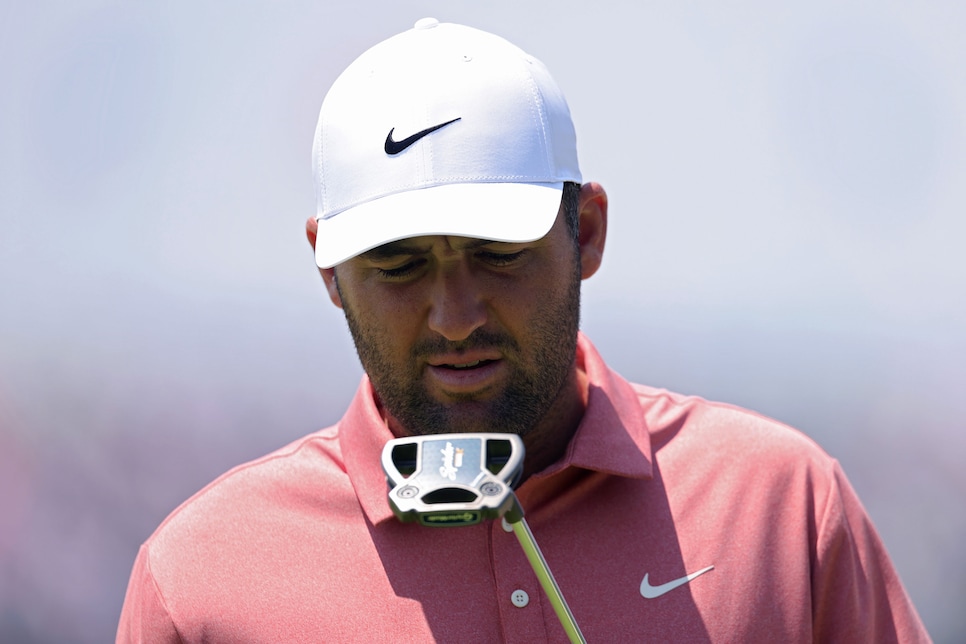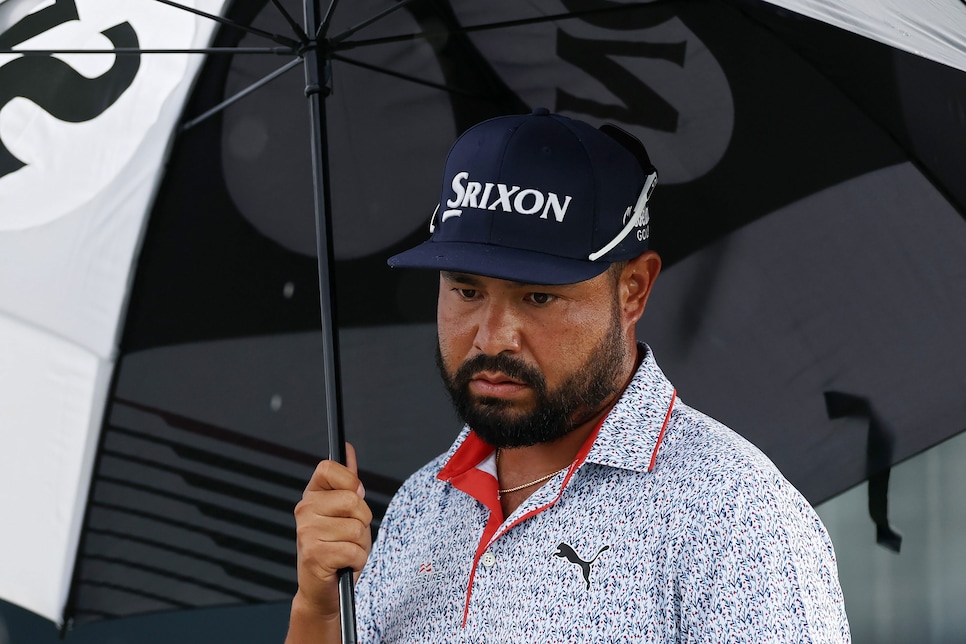OAKMONT, Pa. — If you think that headline looks a little ungrateful, you’re right—we own up to it. This is the U.S. Open, the carnage that some of us wanted is playing out at Oakmont, and there are some interesting names (if not the biggest ones) in the mix as Saturday came to a close. We even got a late flurry at the end of the round that started to show the signs of something more dynamic rearing its head as the final round looms.
So why does it all feel a little boring, especially in comparison to the fireworks at Augusta and Quail Hollow (and hell, even Sawgrass) earlier this year? Here are three reasons, along with a few ways it could change on Sunday to deliver a thrilling final round.
1. Oakmont is giving us the wrong kind of carnage
Right now, I’m purely talking about aesthetics. There’s a creeping talking point that Oakmont is too luck-dependent—lies in the rough, fairway run-offs, bounces on the green—but Data Golf, crunching the numbers, found that there is a stronger “skill separation” here than in most events. That means the players who are playing well are being rewarded for it, and the broader conclusion is that Oakmont isn’t just a hard test, but a pretty fair one.
However, from an aesthetic standpoint, the reality is that brilliant play here means hitting fairways, hitting greens and avoiding three-putts (of which there have been a staggering amount, almost double even the year’s second-most difficult event). A “charging” player, like Carlos Ortiz or Adam Scott on Saturday, shoots a three-under 67. A player having an exceptional round shoots a 69. There aren’t a ton of birdie runs, or irons stopping a foot from the pin, or 30-foot putts finding the cup.

Andrew Redington
This is pure war of attrition stuff, and while it’s fascinating in the abstract, it’s not so great as an entertainment product if you like lots of scoring.
There are times when brutal conditions are fun—think anytime the wind is howling and the rain is falling at the Open Championship—but Oakmont’s version, which is mostly just horrendous rough and super-fast, undulating greens—doesn’t give you that same man versus course frisson, even though a truly titanic battle of exactly that nature is raging.
How it might change on Sunday: We saw the course play a good deal easier on Saturday than it had on Thursday and Friday, which was due almost entirely to the rain between the second and third rounds creating more receptive fairways and greens. The forecast for Sunday isn’t great—more wet weather anticipated—so that could easily continue. That said, the rough isn’t going anywhere, and rain won’t singlehandedly override the crazy-fast greens, so don’t expect a sea change. You may have slightly more players finish under par than the four we see currently, but probably not many.
More Golf Digest U.S. Open coverage  U.S. Open Rory McIlroy opens up about why he’s skipped media after third-round 74 at Oakmont
U.S. Open Rory McIlroy opens up about why he’s skipped media after third-round 74 at Oakmont  U.S. Open How was PGA Tour hotshot Ben Griffin as a mortgage loan officer? We asked his old boss
U.S. Open How was PGA Tour hotshot Ben Griffin as a mortgage loan officer? We asked his old boss  Amateurs Call it a pro golf apprenticeship. The kid from the Cayman Islands is loving every minute of it 2. The superstars are getting slaughtered (the Oakmont Curse lives)
Amateurs Call it a pro golf apprenticeship. The kid from the Cayman Islands is loving every minute of it 2. The superstars are getting slaughtered (the Oakmont Curse lives)
I wrote about the superstar curse at Oakmont last week, and while there are some intriguing names near the top of the leaderboard, from Sam Burns to Adam Scott to Viktor Hovland, the really really big names—Scottie Scheffler, Bryson DeChambeau, Jon Rahm, Rory McIlroy, Brooks Koepka, Xander Schauffele—have been shut down to various degrees.
That should be fine, but if you look at recent major champions, we’ve been spoiled to an egregious degree. Seriously, the last six have been Scheffler, McIlroy, Schauffele, DeChambeau, Schauffele and Scheffler. In the 21 majors contested since the pandemic, the lowest profile winner was Brian Harman, but he was a massive outlier; after him, the “worst” winner by profile was Collin Morikawa, and along with the stars mentioned above, we’ve had names like Rahm, Justin Thomas, Koepka, and Phil Mickelson winning. This is not normal, historically, but if superstars capturing majors is your jam, you’ve been spoiled over the last six years, because we’re in the era of kings.

Ross Kinnaird
The pattern seems to be broken here. Going back to a point made above, some people think it speaks to a certain randomness in Oakmont, but it’s not about that. It might be about a certain stylistic deficit of those superstars, who haven’t needed to pass the kind of “no but seriously, this rough is impossible so you better hit fairways” test that Oakmont demands. The better explanation, though, is probably just that the superstars aren’t really playing very well. The strokes-gained leaderboards tell the story: DeChambeau putted miserably on Thursday and couldn’t hit his irons Friday; McIlroy really struggled with the approach both days as he eked out a made cut he almost wish he didn’t make; Rahm struggled off the tee Friday and Saturday to lose momentum; and Scheffler lost strokes off the tee the last two rounds as well, which is beyond uncharacteristic.
In short, it happens—sometimes the best players all struggle at the same time. And hey, Scott isn’t a bad consolation prize.
How it might change on Sunday: The glib answer is “it won’t,” but it’s at least a little intriguing that Scheffler lurks at four over, with Koepka a five over. It would take something Johnny Miller-esque (he was six back when he shot the 63 in 1973) for them to get back in it, plus a few collapses from the top, but chances are better than nil.
3. Weather and play are dimming the atmosphere
There are a couple of surefire ways to keep the fans in a more muted state, and right now, Oakmont is checking all the boxes. First, there are fewer birdies, so fewer moments to cheer for. When all the players walk up the fairway looking roughly like a dying man staggering toward an oasis in the desert, it’s not exactly electric. Second, the rain led to certain areas being cordoned off on Saturday, and the USGA offered refunds to anyone concerned about the weather, which meant fewer fans to begin with. Third, despite the rain, it was also hot and muggy, and incredibly unpleasant even when the skies weren’t opening. Pittsburgh fans are a hearty lot, but even the ones who showed up were facing a minor version of the battle the players dealt with on the course.

Patrick Smith
How it might change on Sunday: The news here is mostly bad. The forecast points to the potential of more rain and potential thunderstorms, and had USGA officials mulling moving up the tee times. All that moisture will ensure that even if the temperature stays cooler, it’s going to be grossly humid all day. There will be ample temptation to stay home, and with delays possibly in the offing, don’t expect a lot of raucous energy to be generated by the crowd.
The conclusion here is two-fold. On one hand, there are a lot of ways to appreciate a fight like the one that’s happening at Oakmont, but you have to summon the sophisticated side of your golf fandom and appreciate resilience and defensive play over the dynamic scoring bursts we witness in other weeks. (That’s probably a decent analogy, by the way—most weeks we’re seeing the peak Golden State Warriors, and this week we’re seeing the brutality of the late 1990s New York Knicks.) On the other, don’t beat yourself up if it all feels a little boring. You’re not alone, and it can be true that Sunday’s winner will have endured something almost mythical in difficulty to cross the line, but also that it won’t be the most entertaining thing you’ve ever seen. That’s OK—variety is the spice of life, and if this isn’t your favorite kind of golf, rest assured that you won’t have to see it again for a long time. Even by U.S. Open standards, this is a brutal throwback, and if the aesthetics leave you uninspired, maybe it can be enough on Sunday to appreciate the rarity.
MORE GOLF DIGEST U.S. OPEN COVERAGE
U.S. Open 101: Answering all your frequently asked questions
How to watch the 2025 U.S. Open
Here’s the record prize money payout at the U.S. Open
If this was Phil Mickelson’s last U.S. Open, it ends with more heartbreak
11 surprising players who missed the cut at Oakmont
Shane Lowry can only laugh after crazy rules blunder
Watch aspiring tour pro make putt to make the cut, let all the emotions out
Mythbusters: How much distance do you lose from thick rough?
The secret everybody misses about U.S. Open carnage
The local rule that could cause some chaos at Oakmont
The top 15 U.S. Opens, ranked
The 18-hole hazard: The U.S. Open rough is impossible and simple
This article was originally published on golfdigest.com




